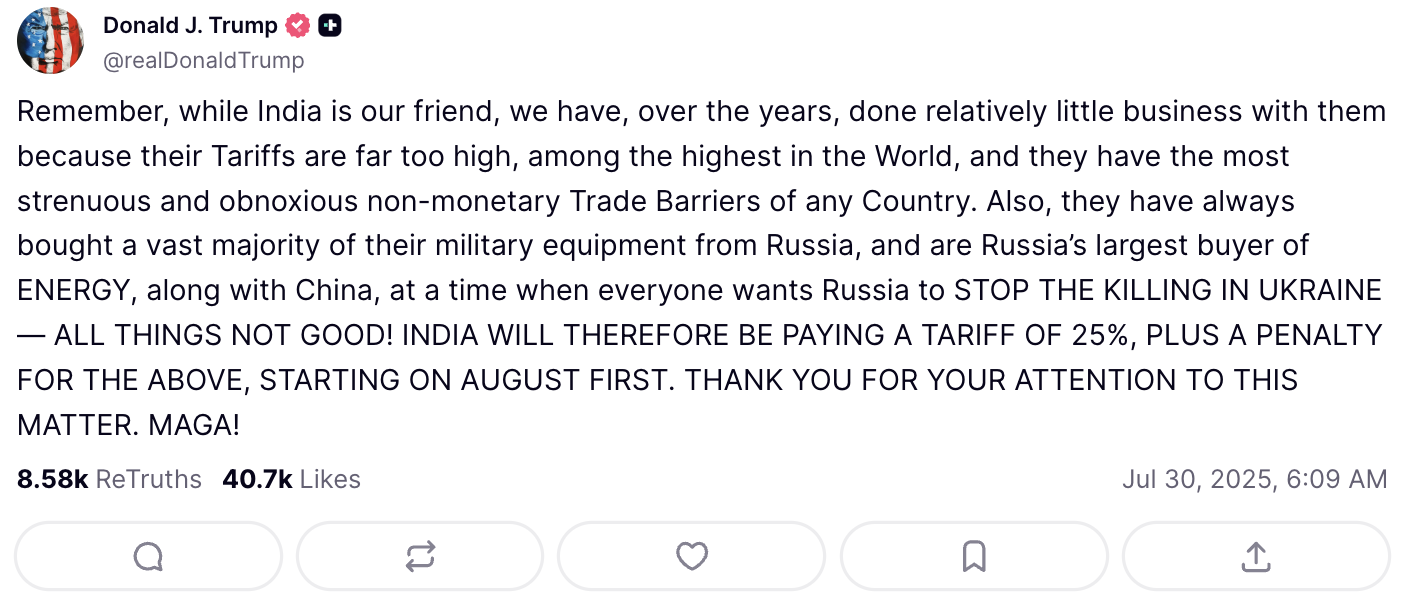The National Artificial Intelligence Action Plan
What has President Trump said this week?
〰️
What has President Trump said this week? 〰️
1. The AI Action Plan
In July 2025, the White House released the National Artificial Intelligence Action Plan, a federal initiative aimed at advancing U.S. leadership in artificial intelligence amid growing international competition. The plan is organized around three strategic pillars: accelerating innovation, developing domestic AI infrastructure, and enhancing international collaboration and security efforts (AI.gov, 2025).
President Trump has described the initiative as a significant step for both economic and national security goals, emphasizing the importance of strengthening domestic AI capabilities and reducing reliance on foreign technologies (The Guardian, 2025). The plan outlines measures such as mandatory cybersecurity testing for large AI models, incentives for reshoring semiconductor manufacturing, and expanded federal training programs in AI-related fields (Forbes, 2025).
In parallel, China’s Premier Li Qiang announced the expansion of its national AI strategy, known as "AI Plus," with a focus on multilateral cooperation across Southeast Asia, Africa, and other Belt and Road partner countries (CNBC, 2025). While the U.S. plan is expected to boost domestic innovation, it may also introduce additional compliance requirements for firms adapting to new governance standards (Forbes, 2025). As global AI strategies evolve, international alignment on AI policy is increasingly framed as a key element of geopolitical and economic influence.
2. Trump Urges Rate Cuts
Following a reported 3.0% annualized GDP growth in Q2 2025, President Donald Trump urged Federal Reserve Chair Jerome Powell to lower interest rates, citing strong economic performance.
The Bureau of Economic Analysis (BEA) attributed the growth to robust consumer spending, steady investment, and rising export volumes (BEA, 2025). Despite the positive outlook, the Federal Reserve held interest rates steady at its July 30 meeting, citing ongoing inflation concerns and global economic uncertainty (Federal Reserve, 2025). While the central bank acknowledged the strength of the latest data, it reiterated the importance of sustained progress on inflation before adjusting policy.
President Trump’s call for rate cuts reflects broader discussions on the relationship between monetary policy and economic growth. While interest rate reductions can support expansion, they may also pose inflationary risks. The exchange highlights the tension between political perspectives and the Federal Reserve’s institutional independence, a topic that has drawn increased attention in recent months.
3. US-India Trade and Tariffs
President Donald Trump recently stated on Truth Social that the U.S. is being “ripped off” by India through high tariffs and trade imbalances, asserting that India purchases large amounts of military equipment and energy from Russia while maintaining unfair barriers to U.S. goods.
The President’s statement reflects his continued focus on reshaping U.S. trade policy, including the proposal to impose a 25% tariff on Indian imports. While concerns over trade deficits and tariff asymmetries have long been part of U.S. trade discussions, recent data present a more layered view of the U.S.-India economic relationship. According to the Global Trade Research Initiative (GTRI), when services, intellectual property royalties, and arms sales are included, the U.S. runs an estimated $35–$40 billion trade surplus with India (Economic Times, 2025).
In goods trade alone, India does maintain a surplus with the U.S., but this is offset by significant U.S. exports in services such as information technology, financial services, and defense.India’s average tariff rates, though higher than those of many developed economies, remain within World Trade Organization (WTO) parameters and reflect longstanding policies aimed at supporting domestic industry (NPR, 2025).
Comments on India’s ties to Russia add a geopolitical layer to the discussion. India continues to balance its strategic partnerships with both Western nations and traditional defense suppliers like Russia. Despite trade tensions, both countries maintain opportunities for mutual growth in sectors such as digital services, pharmaceuticals, and clean energy.



